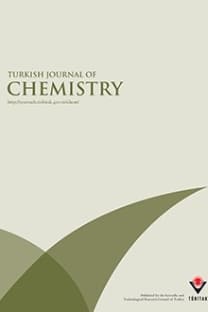Synthesis and application of colloidal CdS quantum dots as interface modification material in perovskite solar cells
Synthesis and application of colloidal CdS quantum dots as interface modification material in perovskite solar cells
___
- 1. Kojima A, Teshima K, Shirai Y, Miyasaka T. Organometal halide perovskites as visible-light sensitizers for photovoltaic cells. Journal of the American Chemical Society 2009; 131 (17): 6050–6051.
- 2. Kim G, Min H, Lee KS, Lee DY, Yoon SM et al. Impact of strain relaxation on performance of a-formamidinium lead iodide perovskite solar cells. Science 2020; 370 (6512): 108–112. doi: 10.1126/science.abc4417
- 3. Heo JH, Lee MH, Han HJ, Patil BR, Yu JS et al. Highly efficient low temperature solution processable planar type CH3NH3PbI3 perovskite flexible solar cells. Journal of Materials Chemistry A 2016; 4 (5): 1572–1578. doi: 10.1039/c5ta09520d
- 4. Yang D, Yang R, Zhang J, Yang Z, Liu S et al. High efficiency flexible perovskite solar cells using superior low temperature $TiO_2$. Energy and Environmental Science 2015; 8 (11): 3208–3214. doi: 10.1039/c5ee02155c
- 5. Seo MS, Jeong I, Park JS, Lee J, Han IK et al. Vertically aligned nanostructured $TiO_2$ photoelectrodes for high efficiency perovskite solar cells: Via a block copolymer template approach. Nanoscale 2016; 8 (22): 11472–11479. doi: 10.1039/c6nr01010e
- 6. Bi D, Yang L, Boschloo G, Hagfeldt A, Johansson EMJ et al. Effect of Effect of different hole transport materials on recombination in CH3NH3PbI3 perovskite-sensitized mesoscopic solar cells. The Journal of Physical Chemistry Letters 2013; 4: 1532–1536.
- 7. Hagfeldt A, Boschloo G, Sun L, Kloo L, Pettersson H. Dye-sensitized solar cells. Chemical Reviews 2010: 6595–6663.
- 8. Wang K, Shi Y, Li B, Zhao L, Wang W et al. Amorphous ınorganic electron-selective layers for efficient perovskite solar cells: feasible strategy towards room-temperature fabrication. Advanced Materials 2016; 28 (9): 1891–1897. doi: 10.1002/adma.201505241
- 9. Chandiran AK, Abdi-Jalebi M, Yella A, Dar MI, Yi C et al. Quantum-confined ZnO nanoshell photoanodes for mesoscopic solar cells. Nano Letters 2014; 14 (3): 1190–1195. doi: 10.1021/nl4039955
- 10. Ke W, Fang G, Liu Q, Xiong L, Qin P et al. Lowerature solution-processed tin oxide as an alternative electron transporting layer for efficient perovskite solar cells. Journal of the American Chemical Society 2015; 137 (21): 6730–6733. doi: 10.1021/jacs.5b01994
- 11. Liu J, Gao C, Luo L, Ye Q, He X et al. Low-temperature, solution processed metal sulfide as an electron transport layer for efficient planar perovskite solar cells. Journal of Materials Chemistry A 2015; 3 (22): 11750–11755. doi: 10.1039/c5ta01200g
- 12. Hwang I, Baek M, Yong K. Core/Shell structured $TiO_2$ /CdS electrode to enhance the light stability of perovskite solar cells. ACS Applied Materials and Interfaces 2015; 7 (50): 27863–27870. doi: 10.1021/acsami.5b09442
- 13. Zhao W, Shi J, Tian C, Wu J, Li H, Li Y, et al. CdS ınduced passivation toward high efficiency and stable planar perovskite solar cells. ACS Applied Materials & Interfaces 2021; 13 (8): 9771–9780. doi: 10.1021/acsami.0c18311
- 14. Dong J, Wu J, Jia J, Fan L, Lin Y et al. Efficient perovskite solar cells employing a simply-processed CdS electron transport layer. Journal of Materials Chemistry C 2017; 5 (38): 10023–10028. doi: 10.1039/c7tc03343e
- 15. Wessendorf CD, Hanisch J, Müller D, Ahlswede E. CdS as electron transport layer for low-hysteresis perovskite solar cells. Solar RRL 2018; 2 (5): 1–10. doi: 10.1002/solr.201800056
- 16. Dunlap-Shohl WA, Younts R, Gautam B, Gundogdu K, Mitzi DB. Effects of Cd diffusion and doping in high-performance perovskite solar cells using CdS as electron transport layer. Journal of Physical Chemistry C 2016; 120 (30): 16437–16445. doi: 10.1021/acs.jpcc.6b05406
- 17. Mohamadkhani F, Javadpour S, Taghavinia N. Improvement of planar perovskite solar cells by using solution processed SnO2/CdS as electron transport layer. Solar Energy 2019; 191 (May): 647–653. doi: 10.1016/j.solener.2019.08.067
- 18. Ma Y, Deng K, Gu B, Cao F, Lu H et al. Boosting efficiency and stability of perovskite solar cells with CdS inserted at TiO2 /perovskite interface. Advanced Materials Interfaces 2016; 3 (22). doi: 10.1002/admi.201600729
- 19. Noel NK, Abate A, Stranks SD, Parrott ES, Burlakov VM et al. Enhanced photoluminescence and solar cell performance via Lewis base passivation of organic-inorganic lead halide perovskites. ACS Nano 2014; 8 (10): 9815–9821. doi: 10.1021/nn5036476
- 20. Zhang F, Song J, Zhang L, Niu F, Hao Y et al. Film-through large perovskite grains formation: Via a combination of sequential thermal and solvent treatment. Journal of Materials Chemistry A 2016; 4 (22): 8554–8561. doi: 10.1039/c6ta03115c
- 21. Guo Q, Yuan F, Zhang B, Zhou S, Zhang J et al. Passivation of the grain boundaries of CH3NH3PbI3 using carbon quantum dots for highly efficient perovskite solar cells with excellent environmental stability. Nanoscale 2019; 11 (1): 115–124. doi: 10.1039/c8nr08295b
- 22. Ma Y, Zhang H, Zhang Y, Hu R, Jiang M et al. Enhancing the performance of ınverted perovskite solar cells via grain boundary passivation with carbon quantum dots. ACS Applied Materials and Interfaces 2019; 11 (3): 3044–3052. doi: 10.1021/acsami.8b18867
- 23. Xue Q, Liu M, Li Z, Yan L, Hu Z et al. Efficient and stable perovskite solar cells via dual functionalization of dopamine semiquinone radical with ımproved trap passivation capabilities. Advanced Functional Materials 2018; 28 (18): 14–16. doi: 10.1002/adfm.201707444
- ISSN: 1300-0527
- Yayın Aralığı: 6
- Yayıncı: TÜBİTAK
Yücel KOÇ, Uğur MORALI, Salim EROL, Hüseyin AVCI
Supramolecular solvents: a review of a modern innovation in liquid-phase microextraction technique
Mustafa SOYLAK, Muhammad Saqaf JAGIRANI
The removal of chromium (VI) from tannery waste using Spirulina sp. immobilized silica gel
Nais Pinta ADETYA, Uma Fadzilia ARIFIN, Emiliana ANGGRIYANI
Novel vic-dioximes: synthesis, structure characterization, and antimicrobial activity evaluation
Dumitru URECHE, Ion BULHAC, Alexandru CIOCARLAN, Daniel ROSHCA, Lucian LUPASCU, Paulina BOUROSH
Study on potential applications and toxicity analysis of green synthesized nanoparticles
Rajni GARG, Priya RANI, Nnabuk Okon EDDY, Rishav GARG
Cyclodextrin-active natural compounds in food applications: a review of antibacterial activity
